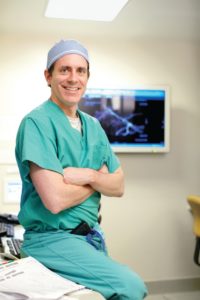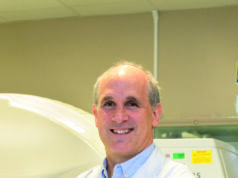 Stephen B Solomon, chief, Interventional Radiology Service, Memorial Sloan Kettering Cancer Center, New York, USA and president of the Society for Interventional Oncology (SIO) talks personalised medicine, immunotherapy and how being a cancer consultant helps make treatment decisions that are not desperation oncology with Interventional News. “Two big challenges [for interventional oncology] are demonstrating clinical data to support our work and ensuring high quality. Compared to other cancer specialties such as radiation oncology, interventional oncology has not been well organised […] this is one of the pressing issues that led to the formation of the SIO,” he explains.
Stephen B Solomon, chief, Interventional Radiology Service, Memorial Sloan Kettering Cancer Center, New York, USA and president of the Society for Interventional Oncology (SIO) talks personalised medicine, immunotherapy and how being a cancer consultant helps make treatment decisions that are not desperation oncology with Interventional News. “Two big challenges [for interventional oncology] are demonstrating clinical data to support our work and ensuring high quality. Compared to other cancer specialties such as radiation oncology, interventional oncology has not been well organised […] this is one of the pressing issues that led to the formation of the SIO,” he explains.
What made you choose interventional oncology?
I love innovation and creativity—interventional radiology is one specialty in medicine that allows practicing clinicians to be both innovative and creative. I have gravitated to interventional oncology, because it is still interventional radiology, but focused on a specific disease state, oncology, which has tremendous opportunity for invention and improvement. For me, the focus on oncology has given me purpose, focus, and mission in my practice of interventional radiology.
In interventional oncology we are a critical part of the cancer patient’s journey and can provide longitudinal care throughout the journey. We are part of the diagnosis (e.g. biopsy), treatment (e.g. TACE), and palliative care (e.g. ascites management). This continuity allows me to have a relationship with our patients rather than simply come in for a procedure and be done.
Finally on a lighter note, interventional oncology has also made answering the cocktail party question of “what do you do for a living?” much easier. When answering “interventional radiology,” there are blank faces, but when answering “interventional oncology” there is a sense of understanding.
What are the three most important considerations when you are a physician treating patients with cancer?
- Be a consultant: In the oncology world the interventional oncologist is a consultant and not a technician. Patients are referred to us not just to do procedures but also for our advice. We must understand our procedures and understand the patient’s disease and course. What stage is this patient in? What is their life expectancy? What might my procedure offer the patient? Will the procedure be providing for improved quality of life? For example, if a patient only has one month to live, then putting them through a procedure that keeps them in the hospital for several days is probably not a good idea.
- Understand the disease and other treatments: You must understand the interplay between what an interventional oncologist can offer and what other specialists can offer. For example, patients with heavily treated livers with chemotherapy or prior radiation may be at higher risk from an interventional oncology treatment. You also need to understand the literature on other treatments. For example, lobectomy for stage 1 primary lung cancer is considered standard of care, whereas surgeons treat metastatic lung cancer with wedge resection. You must understand staging of cancer. For example, to biopsy a breast cancer distant lytic bone lesion is better than to biopsy an axillary node since it will determine upstage the disease and dictate different treatment.
- Show compassion: Many of these patients we see will have a limited life expectancy. They may be quite desperate. It is important to show compassion and empathy, keeping quality of life as a critical part of making decisions. We can offer patients autonomy as individuals, by assisting them in making decisions that are unique to them.
Which innovations have most influenced your career, and how?
I am in awe of the power of CT fluoroscopy. With this imaging tool we can pinpoint and biopsy/ablate 5mm lung nodules in a moving lung! CT fluoroscopy has enabled me to perform percutaneous tumour ablation and successfully cure or palliate hundreds to thousands of patients. While the field began with image-guided ethanol and radiofrequency ablation, it continues to evolve with cryoablation, microwave, high intensity focused ultrasound, and irreversible electroporation. The next step is understanding how these energies interact with human biology. If we can ultimately harness the immune system, we will be able to transition ablation, which is a local treatment, into one that has a systemic effect on metastatic disease.
Why was the Society of Interventional Oncology formed?
Much like the Society of Surgical Oncology is to the American College of Surgeons/European Surgical Association, or the Society of Urologic Oncology is to the American Urological Association/European Association of Urology, the Society of Interventional Oncology is to the Society of Interventional Radiology in the USA or the Cardiovascular and Interventional Radiological Society of Europe (CIRSE). While SIR and CIRSE cover the full range of interventional radiology, the SIO is focused on the subset of interventional oncology. We were formed to make interventional oncology “the fourth pillar of cancer care” along side chemotherapy, surgical therapy, and radiation therapy. The SIO does this through education (in the form of the annual SIO meeting, Fellows courses, and online IO University), research grants and representation (outreach to other oncology associations). We expect our members to also be members of SIR, CIRSE, and APSCVIR. This is where critical governmental issues pertaining to interventional radiology take place. We see SIO as complementary to these other organizations providing foundational oncology research and advocating for the practicing interventional oncologist among the oncology community.
As president of the SIO, what are your key goals for the society in your presidential term?
- Build foundational interventional oncology research to show the value of this discipline. This is being accomplished through our research grant programme which has given out over $1 million to the interventional oncology community in the past year. We are also working with SIR and others to create a multi-institutional registry of procedures that will help create additional clinical evidence for interventional oncology.
- Globally educate for best practices in interventional oncology. The annual WCIO/SIO meeting and the Fellows courses along with our outreach to China and other parts of the world will educate the future interventional oncology specialists. The online IO University is also a way to enable improved education in this field.
- Build representation of interventional oncology specialists in the multi-disciplinary oncology community. We must be represented in the National Comprehensive Cancer Network (NCCN), American Society of Clinical Oncology (ASCO), Eastern Cooperative Oncology Group (ECOG), and European Society for Medical Oncology (ESMO) and other multidisciplinary organisations. We have too often been excluded from guidelines, because we did not have a seat at the table.
In your view what are the biggest developments in interventional oncology today?
Personalised medicine means the recognition that patients have unique cancer gene mutations which must be identified for optimised targeted therapy. This revolution has put the interventional oncologist who performs image-guided biopsy at the centre of cancer care. We should cherish this position and work to improve it. We should also realise that to the oncologist the collection of useful biopsy material is far more important than a chemoembolization procedure. This means that performing biopsies well, can lead to a strong relationship with one of the most critical practitioners in the cancer pathway.
Immunotherapy is the second big revolution in oncologic care. Again, interventional oncology is at the centre of this revolution. Whether we perform ablation or catheter-directed liver therapy, we are creating tumour antigens and a signal to attract the immune response. We have seen in animal models and even some early human studies that these interventional oncology techniques coupled with immune-stimulating drugs can create an enhanced anti-tumour “vaccine.” Further, other advances in oncolytic viruses and nanoparticles are discovering that intra-tumoural delivery has a better result. This intra-tumoural delivery is, again, in the wheelhouse of the interventional oncologist.
We are only beginning to understand the interplay between immunology and the antigen-producing procedures (i.e. ablation or chemoembolization) we perform. It is quite possible that these procedures will be elevated as they develop into a systemic treatment and not just a local one.
What are three early technologies that you are keeping an eye on?
CAR T-cells are having a dramatic effect on the “liquid” cancers (i.e. lymphomas, leukemias), however, the effect has been more challenging in the solid tumours. There is some evidence that intratumoural delivery would aid in the effect on solid tumours and interventional oncologists are well positioned to “drive the CARs” where they need to go.
Oncolytic virus and “cancer eating bacteria” have shown positive results when injected intratumourally. T-VEC is the first approved oncolytic virus. It is approved for injection in superficial melanoma. Studies are now being done with interventional oncologists injecting under image-guidance into deep lesions. Other similar virus and bacteria injections are being investigated.
Interventional oncologists have used anatomic imaging such as ultrasound, fluoroscopy, CT, and MR to perform procedures. However, in oncology, metabolic imaging is oftentimes critical. Tumour heterogeneity and differences in viability after prior treatment can be best distinguished with metabolic imaging. PET guided interventions open a new avenue for interventional oncologists. For example, PET may allow detection of viable cancer cells after ablations enabling retreatment while the patient is still on the procedure table. With advancement in specific cancer radiotracers beyond fludeoxyglucose (FDG) such as prostate-specific membrane antigen (PSMA), there will be additional opportunities for PET-guided interventions.
In the past few years the concept of “personalised medicine” has revolutionised oncology. The interventional oncologist is central to this revolution, as we are the ones often responsible for acquiring the tissue necessary to perform the “personalised medicine.” When we do a poor job, we are the scapegoats, and when we do a good job, we are the heroes. Doing a good job requires good communication with the referring oncologist to ensure that an understanding between the delicate balance of safety and obtaining adequate tissue for molecular analysis is possible. Personalised medicine has put a priority on us doing a high quality job. This is an area for our specialty to work on to ensure that this critical part of the cancer patient’s care is done at a high level. We are doing an ever-increasing number of needle biopsies, and service and quality are paramount.
You have been a prolific inventor of devices in various fields. Could you describe some of these devices?
I love innovation and have spent most of my career focused on creating solutions for problems. I have developed a range of devices spanning cardiology, oncology, pulmonary, urology, and obesity. One of the first concepts I worked on was a Global Positioning System (GPS) electromagnetic sensor for interventional tools. We demonstrated this in the transjugular intrahepatic portosystemic shunt (TIPS) procedure, and with inferior vena cava filters. However, we got the most traction in cardiac electrophysiology. The device is called CARTO sold by Johnson and Johnson and is the standard of care throughout the cardiac electrophysiology world. It uses GPS on a catheter to measure the heart’s electrical signal and position and creates an electrical map of the heart. We then fused the electrical map to MRI/CT images. As an offshoot of this GPS catheter, I put the sensor on the end of a bronchoscope which created the field of electromagnetic navigational bronchoscopy which became the basis for the SuperDimension device now sold by Medtronic. Another device I created was the Aspire Assist obesity device which is on the market for treating morbid obesity. This concept uses a reverse gastrostomy tube to remove calories from the stomach before absorption, and although controversial, is as good as the lap band yet, safer and easily reversible. I created the split-dose concept for PET-guided tumour ablations which uses a small FDG dose to guide ablation needle placement followed by a second larger FDG dose at the end of the ablation to assess for completeness while the patient is still on the procedure room table. At our institution this has become the standard of care for FDG avid liver ablations. I also helped develop the first software for vessel tracking to guide intra-arterial therapies. This software is called LiverCare and is sold by GE Healthcare. Finally, I helped create a venture capital firm through which I was able to contribute and help nurture multiple other technologies.
What are the biggest challenges for interventional oncology in 2018?
Two big challenges are demonstrating clinical data to support our work and ensuring high quality. Compared to other cancer specialties such as radiation oncology, interventional oncology has not been well organised. Radiation oncologists have RTOG (Radiation Therapy Oncology Group), for example, that helps organise clinical trials and provide the infrastructure to recruit patients quickly to allow rapid generation of clinical data. This is one of the pressing issues that led to the formation of the SIO. The SIO hopes to provide similar infrastructure support to allow rapid generation of interventional oncology clinical data. More and more payors and referrers are looking for the clinical evidence to support decisions. Without such formal evidence, we in interventional oncology may suffer. The SIO is working with SIR and others to build the Interventional Oncology Clinical Outcomes Registry (IO-CORE) which will be a multi-institutional registry for interventional oncology procedures.
Another important area for us to emphasise is quality. Again, the SIO through education courses being offered worldwide and through the online IO University are teaching high quality to IO practitioners. It is essential to realise that the procedure is only one component to good care. We need to make sure interventional oncologists understand the disease, treatment alternatives, and where interventional oncology fits in.
Could you describe a memorable case?
One memorable case is that of a 42-year-old woman who had metastatic colorectal cancer. Her disease was controlled except for a few lung metastases. I was able to ablate her lung metastases and give her a “chemo holiday” which was great. That was five years ago. However, what was so memorable about the case was the handwritten letter I received from her young children written in crayon thanking me for keeping their mommy alive. These are the kinds of things that make our careers meaningful and remind us that each patient has a family around them that cares so much about what we do. I remind myself of that letter all the time with each patient I treat.
What are your interests outside of medicine?
My other passion is my family. I have an amazing wife who is a singer, songwriter, and fashion entrepreneur. We have two terrific boys aged three and five with whom we spend as much time as possible introducing them to the fascinating world we live in. On weekends, we take the boys to the Museum of Natural History, classical music concerts, apple picking, kayaking, and golf.











